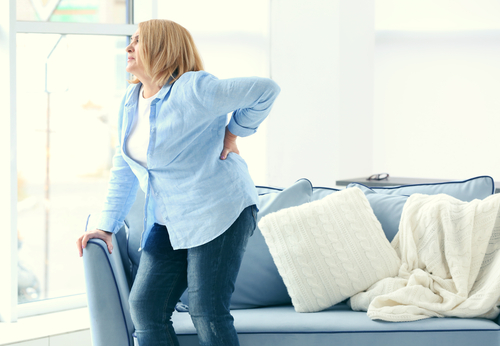Back Pain: What Causes it and What Can You Do?

The spine is divided into three portions: the cervical (upper portion), the thoracic (middle portion), and the lumbar (lower portion). Each portion of the spine has a different natural curve that acts as both protection of the back and allowance of proper movement. Over time, the effect of gravity has the potential to influence these natural curves to run out of alignment, thus causing poor posture. When the natural curvature of the spine is altered, muscles are susceptible to weaken, fatigue, and/or tighten, which can directly correlate to back pain and spasms.
When certain back muscles have weakened/tightened, it puts an individual at risk for potential muscle or ligament strains within the back. Certain motions such as repetitive bending and heavy lifting without proper strength or movement may exacerbate a strain to the back and potentially cause painful movement. If muscles within the back are not working as efficiently as they should, additional stress can be placed onto the intervertebral discs that cushion the spine. This poses the risk of rupturing discs and puts pressure on spinal nerves.
The spinal column is one of the most important structural support systems within the body. It consists of 33 vertebral bones that attach to form the spine in order to allow for bending and rotational movements within the back. In between each of the vertebral bodies lies a cushion-like structure known as intervertebral discs, along with surrounding ligaments that provide protection of the bones. Different muscles attach to the back to allow for forward bending and backwards leaning to help carry out our day-to-day activities.

Symptoms
Symptoms will vary depending on the type of tissue that may be involved within the back. Back pain caused by muscle weakness usually presents with muscle spasms during prolonged sitting, standing, or at rest. Strains that originate within the back may present with pain during certain bending or twisting motions. A herniated disc may present with no symptoms at all or pain within the low back with accompanying weakness, numbness, or tingling down the leg.
What You Can Do
Physical therapy has been proven to act as an effective means of treatment for back pain. Upon arrival, a licensed physical therapist will carry out a screening to confirm that your issue is originating from the back and not referred from other joints. They will determine the level of the spine your symptoms are coming from and create an intervention plan tailored to your needs to help you get back to what you love doing, pain-free. Interventions for back pain can include proper stretching, strengthening, functional activity, soft tissue mobilization, joint mobilization, laser therapy, and patient education all guided with the help of your therapist.

